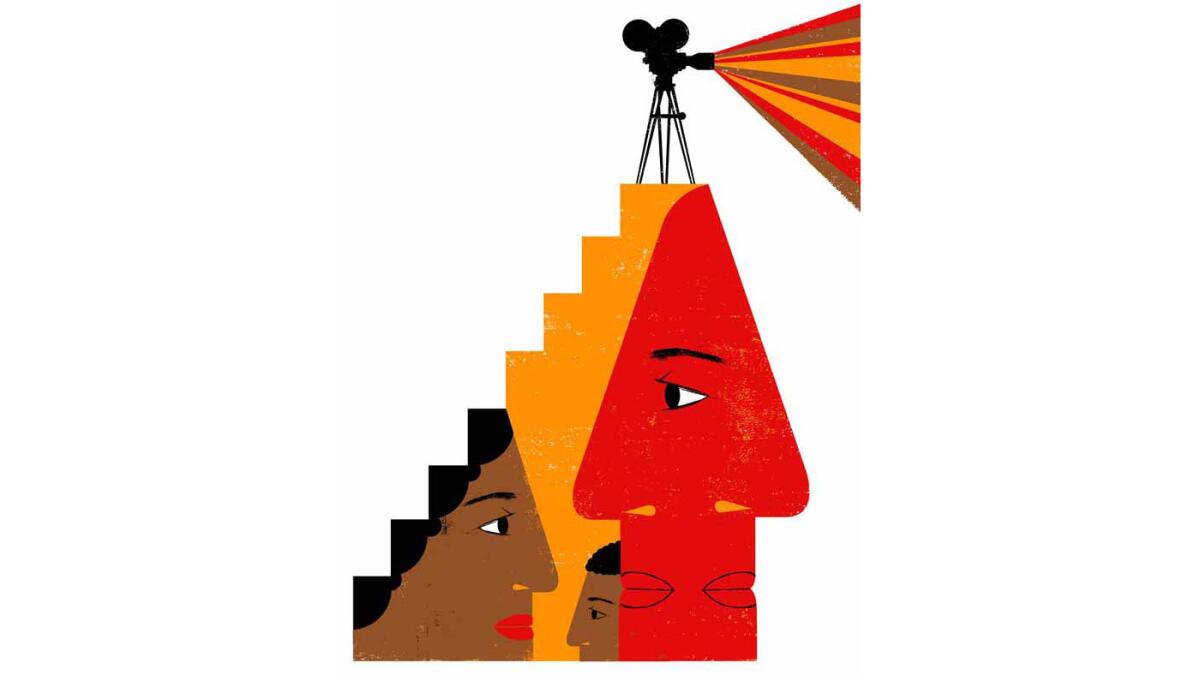Best of 2015: Is 2015 the tipping point for women and minorities in Hollywood?

2015 may have been a turning point in the conversation about gender and race in Hollywood.
In a recent interview, Mike De Luca, the prominent producer of âThe Social Networkâ and âFifty Shades of Grey,â wondered aloud something that shocked me in its openness and introspection: âDo I seek out other white men?â
In five years of asking white male producers and executives about the issue of racial and gender discrimination in Hollywood, De Lucaâs comment was the first time I had ever heard genuine soul-searching in response.
In an era when a single comment can be contorted into a shaming meme on social media, I understand the hesitation of public figures to discuss this hot-button topic with a reporter. Todayâs moment of candor is tomorrowâs mortifying hashtag. Over the years of asking, I have become accustomed to an array of responses â discomfort, defensiveness, bewilderment and the sudden failure of a cellphone signal, to name a few.
De Lucaâs candid comment, which came after he participated in a conversation about unconscious bias at an industry meeting in October organized by the advocacy group Women in Film, struck me as signifying a tipping point, a moment when Hollywood seems poised to change its long-standing behaviors of excluding women and people of color from key creative jobs.
Thereâs no doubt this has been a year of constant pressure on the entertainment industry, from within and without, and from governmental and market forces, on the issues of race and gender. There are those who say weâve been here before, that diversity is like a wave that periodically hits the shores of Hollywood only to recede.
SIGN UP for the free Indie Focus movies newsletter >>
But Iâd like to believe that something is different now â the crush of evidence of the industryâs inequality is too big, the wrath of social media is too fierce to ignore. The tone and the tenor of the message has changed â at awards dinners and Hollywood luncheons â the topic of inclusion isnât the appetizer, itâs the main course.
Change is here
Those who have long advocated for change are beginning to see the fruits of their labor. A steady drumbeat of data from researchers at USC and UCLA suggests women and minorities are at a disadvantage when it comes to hiring in behind-the-camera positions, and this fall, the federal Equal Employment Opportunity Commission began contacting female directors who said they have been subject to discrimination.
At the same time that research suggests women and minorities overall are under-represented, some high-profile successes among films and TV shows headed by women and people of color this year have demonstrated their effect on the business â and the potential for more.
Audiences have embraced F. Gary Grayâs âStraight Outta Compton,â Ryan Cooglerâs âCreed,â Sam Taylor-Johnsonâs âFifty Shades of Grey,â Elizabeth Banksâ âPitch Perfect 2,â Nancy Meyersâ âThe Intern,â Lee Danielsâ âEmpireâ and Shonda Rhimesâ âScandal,â and studios and networks have happily tallied the cash they generated.
In front of the camera, the yearâs most anticipated movie, âStar Wars: The Force Awakens,â seems poised to be one of its most inclusive, with a black Stormtrooper, a woman pilot and an array of other key roles breaking the mold, while others of the yearâs biggest box-office drivers, from the seventh film in the ethnically diverse âFast and Furiousâ franchise to the closing movie in the female-led âHunger Gamesâ series, have confirmed that audiences show up when they see a heroic version of themselves represented on-screen.
READ MORE: The 10 (or 20) best movies of 2015, according to Mark Olsen
Over the course of the year, women and minorities in the business have been using their platforms as advocates with increasing power: Patricia Arquette tipped off the conversation with a fiery plea for wage equality for women in February at the Oscars and Viola Davis drove home the point with a poignant reference to Harriet Tubman and the lack of opportunities for women of color in September at the Emmys.
Jennifer Lawrence published a widely circulated letter decrying the pay gap between men and women, and Spike Lee used the occasion of receiving his honorary Oscar in November to question the lack of black faces in studio executive suites.
More opportunities
Other, more systemic changes are afoot. The Academy of Motion Picture Arts and Sciences, which began 2015 with an all-white group of acting nominees, has recently invited larger, more diverse classes of new members, and its president, Cheryl Boone Isaacs, the first black woman in that prominent job, announced a new initiative called A2020 to improve the representation of women and minorities among its staff and leadership.
Some in the industry are using their access to prop the door open wider for others: Geena Davis meets regularly with studios, imploring them to add more female characters to their scripts; Meryl Streep is backing a lab for female screenwriters over 40; and âSelmaâ director Ava DuVernay has used the success of the best picture-nominated film she made for Paramount Pictures to broaden the scope of her own distribution company, Array, which releases films by women and directors of color.
In May, a female filmmaker named Destri Martino created the Director List, a database of more than 1,000 working female filmmakers designed to be used by executives and producers looking to find female candidates for jobs.
READ MORE: âBrooklynâ tops Kenneth Turanâs best films of 2015
As the voices of women and people of color in the industry are growing louder and more insistent, they are being echoed, tentatively but increasingly, by the voices and actions of white male decision-makers like Paul Feig, the director of women-driven comedies including âSpy,â âBridesmaidsâ and the upcoming âGhostbustersâ movie; Lorne Michaels, who has expanded the opportunities for black and female performers on âSaturday Night Liveâ; and Netflix executive Ted Sarandos, who has backed an array of programming reflecting diverse perspectives, including the womenâs prison series âOrange Is the New Black,â the Africa-set boy soldier movie âBeasts of No Nationâ and the new Aziz Ansari show âMaster of None.â
Many women and minorities I talk to in the industry are concerned with how to make 2015 not a brief moment of public awareness that benefits a few, lucky people, but an opening to lasting, systemic change. Itâll be years before we know if 2015 is really the tipping point it seems to be in Hollywood, rather than that year when the hashtag âdiversityâ was trending. But Iâll take it as a sign if there are more Mike De Lucas willing to take my calls, and sincerely ask themselves the hardest questions.
More to Read
Only good movies
Get the Indie Focus newsletter, Mark Olsen's weekly guide to the world of cinema.
You may occasionally receive promotional content from the Los Angeles Times.











